Chronic pain is something that an unbelievable number of people deal with regularly. It can come from many different sources, some of which can’t be cured. In some cases, it can be a lifelong condition.
In these cases, the best thing doctors can do is help their patients manage the pain, usually with medications. However, scientists have proven that yoga effectively improves constant pain in many people. Keep reading to find out how.
What is Chronic Pain?
Everyone can name a cause of pain because there are so many. Injuries, arthritis, toothaches, headaches – the list of pain sources could be a mile long. However, those are causes, not a definition of what pain is.
Understanding why yoga can relieve chronic pain is easier when you know exactly what pain is. The short definition is pain is your body’s way of telling you something is wrong. It’s essentially your body’s way of communicating with you.
Constant pain does more than cause a person to hurt. It affects every aspect of a person’s life. There are mental, physical, and even social consequences in dealing with the condition, such as reduced mobility and depression. Unfortunately, medications sometimes provide little relief.
Mental Consequences
It shouldn’t be any surprise that a person who is constantly in pain might be in a sour mood sometimes. Eventually, as they learn to tolerate the pain, they may be able to hide it, but there will be times when they feel overwhelmed. These feelings can lead to insecurity, elevated stress, and depression.Difficulty sleeping is a common problem for people who suffer from constant pain. According to a 2006 survey, over 85% of people who suffer from constant pain reported having sleeping problems. They may also have anxiety or even feelings of guilt.
Physical Consequences
Of course, the most apparent physical consequence of constant pain is unrelenting discomfort. However, it goes deeper than that. Constantly being in pain hampers your mobility, leading to problems like stiffness and inflexibility.
Stiffness and inflexibility lead to even less mobility. People think of mobility issues as age-related, but chronic pain can cause this problem at any age. Less mobility can cause other problems like cardiovascular disease, weight gain, diabetes, and more. It’s a big spiral effect that can lead to a severe physical decline.
Social Consequences
Chronic pain doesn’t just affect the afflicted person. It has consequences for the person’s family and friends. The afflicted person may miss out on quality time with loved ones due to being in pain. Their mental state can prevent them from bonding with loved ones. They may even end up with sour relationships at work.
When people deal with constant pain, it changes their personalities and their quality of life. They may try to pretend like they’re okay, and the pain may even be tolerable, but it’s always there. In many cases, the person deals with the condition alone because they don’t want to burden their loved ones. It’s a very unpleasant way to live.
That’s why the idea of relieving constant pain with yoga is so attractive. Yoga is an exercise that improves your mind and your body. The poses, even the basic ones, combat constant pain by relieving it at the source.
As you can see, there are many consequences to constantly being in pain, so it’s great that scientists have proven that yoga can be a relief.
What is Yoga?
Yoga is an exercise that focuses on total body enhancement. It exercises the mind just as much as it does the body. While yoga is an exercise, it’s more spiritual and philosophical in nature than it is scientific.
Yoga originated in India. It’s one of the six Āstika schools of Hindu philosophical traditions. The idea of yoga is to suppress the negative and unbalanced thoughts of the mind to achieve balance, enlightenment, and blissful ecstasy. You could say that yoga can free your mind from worldly things’ bondage and liberate your spirit.
A New Study Reveals How Yoga Improves Chronic Pain in 89% of People.
Scientists have discovered that yoga has the opposite effect on the brain of chronic pain. That makes it the perfect solution to a constant pain problem. In fact, in a study published in the Journal of the American Osteopathic Association in September of 2020, researchers found that 89% of participants agreed that yoga helped reduce their chronic pain. The remaining 11% were neutral in their opinions.
What’s clear from this study is that even though yoga poses may be a bit demanding to get into and hold, it won’t aggravate your pain. You’ll have a big chance it will give you some much-needed relief.
How Yoga Helps with Constant Pain
Freeing your mind from the pain is one way that yoga helps. But it can also liberate you of pain in more tangible ways. In yoga, you focus on breathing, posing, and stretching, all while clearing the mind. There may be meditation involved.
Physically, yoga stretches and strengthens muscles and joints. According to researchers at Harvard Health, many of the poses have a lot in common with standard therapeutic exercises, which can help to rehabilitate which can help alleviate constant pain. The following section has some popular yoga forms, known as asanas, that can help with pain relief.
Asanas and Their Applications
There are many ways of categorizing asanas. Four popular types of asanas are culturing (physical), strengthening, relaxing, and meditative. All of them can help to relieve pain in their own way. Asanas can also be combined, which can help target some of the worst pain in your body.
Back Pain
One of the biggest causes of back pain is the misalignment of the spine. Yoga is excellent for correcting alignment and improving posture. It would be best if you started with relaxation asanas first, then move to the strengthening asanas. Starting with strengthening asanas first can make the pain worse. Here are some relaxation and strengthening asanas that can relieve back pain:
Relaxation Asanas
- Reclined Bound Angle Pose
- Mountain Pose
- Corpse Pose (savasana)
Strengthening Asanas
- Thread the Needle Pose
- Downward Facing Dog
- Extended Triangle Pose
Fibromyalgia or Myofascial Pain
An overactive sympathetic nervous system can cause both conditions. Being stressed out can negatively and painfully affect the musculoskeletal system. You may have heard the phrase, “it’s all in your head.” This statement can apply to these conditions.
While stress doesn’t cause the conditions, it does aggravate them. So, using yoga to destress can relieve the pain associated with them. Here are some asanas that can be used to melt away stress:
- Forward Fold
- Cat/Cow Flow
- Eagle Pose
- Child’s Pose
Knee Pain
Arthritis is one of the primary causes of knee pain. Unfortunately, there is no cure for arthritis, so doctors aim to manage the pain and inflammation of the tissues. This could be through medication or exercise. However, yoga is great for relieving constant knee pain.
Plenty of asanas will stretch your knees and relieve knee pain. These asanas don’t require rotation, so they won’t make the pain worse. Here are a few:
- Reclined Hand-to-Big-Toe Pose
- Bridge Pose
- Banana Pose
Nerve Pain
Nerve pain can be excruciating and even debilitating. Also called neuropathic pain,
it’s essentially pain due to degeneration of the nerves. While most cases of neuropathy can be reversed once the doctor has discovered the source of the pain, it’s still hard to deal with until treatment is completed.
Yoga can help people get through neuropathy by providing some relief. One technique that can help is known as yoga Nidra. It’s a meditative asana that is sometimes called yogic sleep.
Yoga Nidra is done in savasana (the corpse pose), which is ideal for people with nerve pain because you don’t have to hold yourself in tough poses. The idea of yoga Nidra is to go through the five layers of self, and in the end, you come out whole. This melts away stress and pain.
Final Thoughts on How Yoga Can Improve Chronic Pain
According to the Centers for Disease Control (CDC), chronic pain affects more than 50 million Americans. On a global scale, the percentage is even worse. It’s a problem that adds to other crises, such as opioid addiction, depression, and mobility issues.
If more people incorporate yoga into their lives, it can provide them the relief they seem from constantly being in pain. Plus, they’ll experience other health benefits. Yoga is such a convenient treatment – it can be done from the comfort of home for a minimal amount of money (the cost of a yoga mat). Since science has proven that it reduces chronic pain, there is nothing to lose by doing yoga.
















 Community
Community

